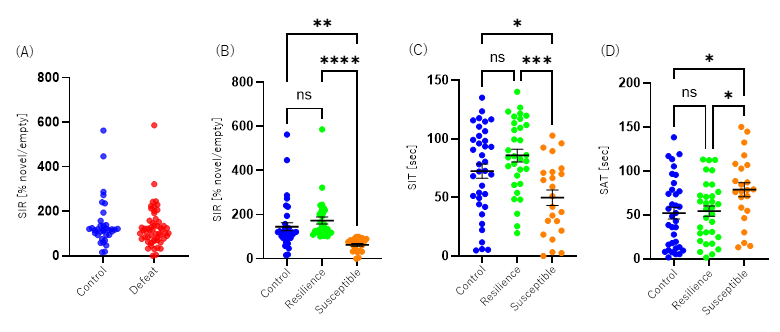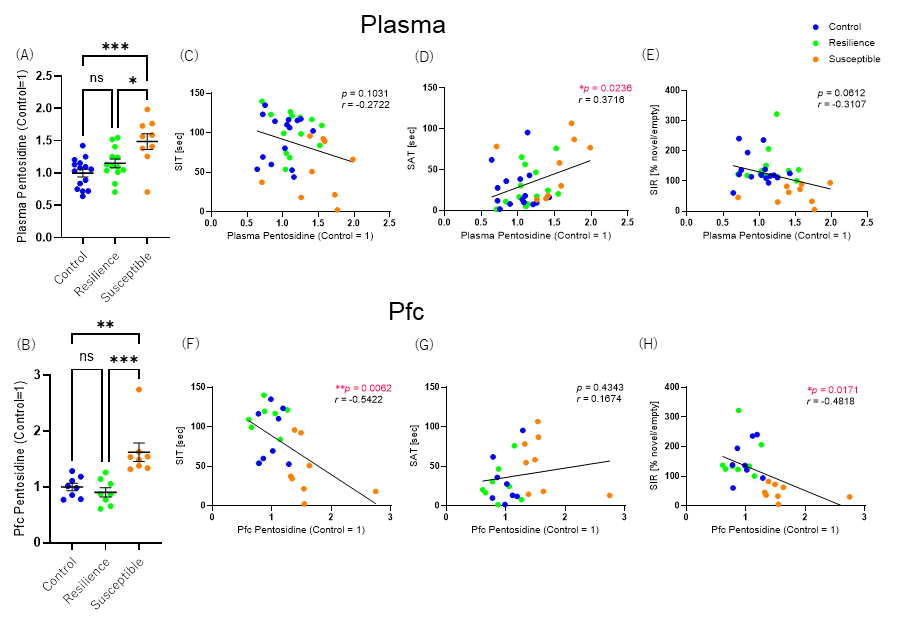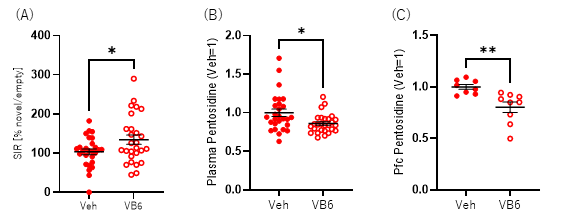
Masada M, Toriumi K, Suzuki K, Miyashita M, Itokawa M, Arai M. Role of pentosidine accumulation in stress-induced social behavioral deficits. Neurosci Lett. 2025 Feb 27;852:138180.
doi: 10.1016/j.neulet.2025.138180. Epub ahead of print. PMID: 40023363.
doi: 10.1016/j.neulet.2025.138180. Epub ahead of print. PMID: 40023363
Glycation stress is a pathological process caused by the accumulation of advanced glycation end products (AGEs), which has been implicated in schizophrenia. Our laboratory has identified that a specific AGE, pentosidine, accumulates in approximately 40% of patients with schizophrenia and reported its correlation with negative symptoms [1]. Furthermore, vitamin B6 (pyridoxamine), an inhibitor of AGE synthesis, has been shown to suppress pentosidine accumulation and improve some symptoms [2].
On the other hand, social stress is also closely related to the onset of schizophrenia, with individuals highly vulnerable to stress being at an increased risk. Stress-induced hyperglycemia is known to promote AGE formation, leading to oxidative stress, inflammation, and subsequent cellular damage [3,4].
In this study, we used a social defeat stress (SDS) mouse model to investigate the relationship between social stress and schizophrenia from the perspective of glycation stress. The findings of this study are expected to contribute to elucidating the molecular mechanisms of schizophrenia and to the development of new prevention and treatment strategies.

(A) Mice were classified based on the social interaction ratio (SIR), a key indicator in the social behavior test, by comparing the control group and the stress-exposed group (Defeat). Mice with SIR > 100 were classified as the “Resilient” group, while those with SIR < 100 were classified as the “Susceptible” group.
(B) SIR, (C) SIT, and (D) SAT were compared among the control, resilient, and susceptible groups. The susceptible group showed a significant decrease in SIR and SIT, along with an increase in SAT.
Next, we measured pentosidine levels in plasma and the prefrontal cortex (Pfc) using HPLC. As a result, exposure to SDS led to a significant increase in pentosidine levels in both plasma and the Pfc of the susceptible group (Figure 2A-B). These findings suggest that stress vulnerability is associated with pentosidine accumulation.
Furthermore, we analyzed the correlation between social behavior and pentosidine levels. Plasma pentosidine showed a significant positive correlation with SAT (Figure 2D) and a negative correlation trend with SIT (Figure 2C) and SIR (Figure 2E). On the other hand, Pfc pentosidine showed a significant negative correlation with SIT (Figure 2F) and SIR (Figure 2H), while exhibiting a positive correlation trend with SAT (Figure 2G). These results indicate that higher pentosidine levels are associated with impaired social behavior.

(A) Pentosidine levels in plasma and (B) Pfc were compared among experimental groups, showing increased pentosidine accumulation in the susceptible group.
(C)–(E) Correlation between plasma pentosidine levels and behavioral indices.
(F)–(H) Correlation between Pfc pentosidine levels and behavioral indices. Higher pentosidine accumulation was associated with impaired social behavior.
Next, to examine the relationship between pentosidine accumulation and the decline in social behavior, we administered pyridoxamine, an AGE synthesis inhibitor, during SDS exposure to assess whether it could improve social behavior impairment. The SDS-exposed mice were divided into two groups: the vehicle-treated group (Veh) and the pyridoxamine-treated group (VB6), with administration occurring during SDS exposure.
The results of the social behavior test showed that pyridoxamine administration improved the SIR, which had been reduced by SDS exposure (Figure 3A). Furthermore, HPLC analysis of pentosidine levels in plasma and the PFC revealed that pyridoxamine administration suppressed the SDS-induced increase in pentosidine accumulation (Figure 3B-C).
These findings suggest that pentosidine accumulation due to social stress may be a causative factor in social behavior impairment. Additionally, pyridoxamine administration may have the potential to prevent social stress-induced behavioral abnormalities.

(A) Comparison of SIR between the vehicle-treated group (Veh) and the pyridoxamine-treated group (VB6) showed that pyridoxamine administration improved SIR.
(B) Comparison of pentosidine levels in plasma and (C) Pfc revealed that pyridoxamine administration suppressed social stress-induced pentosidine accumulation.
These findings demonstrate that pentosidine accumulates in the SDS model and that there is a significant correlation between pentosidine accumulation and social behavior impairments. This suggests that pentosidine accumulation may contribute to social behavior abnormalities.
While many studies have reported stress-induced social behavior impairments, this study is the first to identify pentosidine as a molecular factor underlying these impairments. Further elucidation of the molecular mechanisms by which pentosidine affects social behavior could lead to the development of novel molecular therapeutic strategies for improving social behavior deficits in schizophrenia.